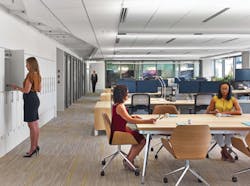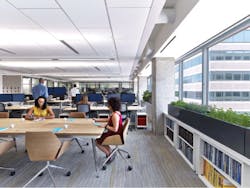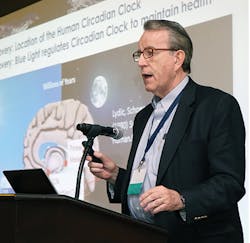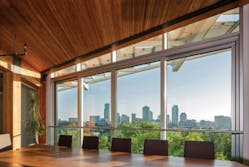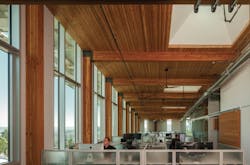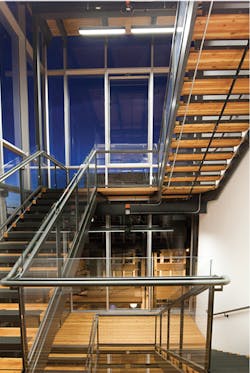While it might make sense to turn up the Kelvin settings during the day and down toward night, it's not always that simple. MARK HALPER discovers the virtues of spectral power and natural light at offices from coast to coast in the US.
As our modern lives emphatically defy the planet's natural day/night cycle we are, plainly put, messing with our bodies' circadian clocks. Our physiology has evolved over millions of years to conform with 24-hour patterns of sunrise and sunset, yet our contemporary non-stop work and play habits fight brutally against that conditioning.
Interested in articles & announcements on human-centric lighting projects and technology?
And there is perhaps no greater symbol of our new clock-defying norm than electric light, which has generally kept the gates wide open to nocturnal land for well over a century in the developed world.
Many efforts are now underway to study the impact of light on the circadian rhythm, and how to engineer lighting systems to be good circadian citizens. Those efforts are intensifying now that LED lighting has arrived. LEDs' digital nature makes them relatively easy to tune to settings that might support circadian needs.
LED lighting has gained a reputation for both good and bad on the circadian scene. On the good side, the blue frequencies that tend to be common in white LED light can stimulate, which is desirable, say, in the morning, or at a math class when you need to pay attention. But blue can keep you awake at night when you need to sleep. Conversely, ambers and reds can help you relax. More bad: Blues at the wrong circadian time have been linked to serious health issues such as cancer and diabetes, and so on.
FIG. 1. Employees at ASID headquarters work in finely tuned spectral power conditions. (Photo credit: Benya Burnett Consultancy/Eric Laingnal/Perkins & Will Architects.)
The scientific understanding is still evolving. It's very much in its early days and is subject to debate. For a basic understanding of some fundamental precepts: Blue frequencies stimulate the brain's master clock because they stoke up a pigment called melanopsin which resides in the retina's non-visual photoreceptors (non-visual photoreceptors are different from the visual photoreceptors known as rods and cones); and blue suppresses melatonin, a hormone associated with helping us fall asleep.
With that in mind, offices around the world are beginning to deploy lighting systems that try to make the most of our circadian rhythm. LEDs Magazine has written many articles over the past couple of years on the subject, including last year's two-part special looking at deployments in hospitals and in the workplace. We've followed that with another two-parter this year. The first installment ran in our last issue (http://bit.ly/2yRrodB), looking at buildings in the US and in the UK, at the impressive research and field studies by Rensselaer Polytechnic Institute's Lighting Research Center, and at control systems from Casambi.
Here in Part 2, we delve deeper into the science, discovering the important distinction between correlated color temperature (CCT) and spectral power distribution (SPD), and the importance of natural light. And we peek into the lighting design at a couple of different award-winning buildings.
FIG. 2. ASID employees benefit from natural light as well as artificial. And the office's north-facing windows provide ample natural light but less glare than if they were facing south. Photo credit: Benya Burnett Consultancy/Eric Laingnal/Perkins & Will Architects.
Whatever you want to call this subject - it goes by the names human-centric lighting and circadian lighting, or lighting for health and wellbeing - rest assured that it will continue to gain attention and help drive the lighting industry. It's a pillar in the field of human circadian studies, the general importance of which is growing, as evidenced last October when Nobel judges awarded the Nobel Prize in Physiology or Medicine to three US scientists for their work in explaining how the circadian clock works.
Lighting is not the only factor of modern living that is disrupting circadian cycles. Heating and air conditioning (temperature), physical activity or lack thereof, eating habits, and much more all play a role. But along with temperature and food intake, light is one of the three or so primary influences - circadian scientists call them "zeitgebers" from the German word for time giving, or timekeeper. Zeitgebers like light can turn gene functions on and off. They have a huge impact on health, mood, energy level, and all sorts of other things.
In a world where most people spend more time indoors than out, and where nighttime tends to be light time whether outside or not, it's imperative to gain a better understanding of lighting's circadian effects - and what to do about them. Here are some people and places that are trying.
* * * *
ASID HQ has the power -The spectral power
As the concept of human-centric lighting gains credibility, the common wisdom is that blues stimulate, ambers relax. Thus, designers are tending to specify systems that deliver those frequencies at the desired time of day or in the desired setting. Typically, they might focus on the correlated color temperature, prescribing systems that adjust the CCT. For example, lights might deliver cool-blue 5000K and 6000K temperatures to stimulate in the morning, while resetting to the warmer 2700K zone of amber colors at rest time. (In case you need a reminder, temperatures in the counterintuitive "K" or "Kelvin" scale are cooler at higher numbers.)
But it's not quite that simple, noted Deborah Burnett, principal and partner at lighting design firm Benya Burnett Consultancy. While different CCTs are indeed associated with different biological responses, it is not the CCT per se that elicits the different reactions.
Rather, notes Burnett, it is the energy released by light, a quality characterized by SPD. As that energy hits human eyes and human skin, it will trigger biological responses. SPD accurately defines the energy in light across the range of human visual sensitivity. The fact is that even if two light sources have the same CCT, they can have decidedly different SPD curves.
"If you rely on CCT, you are ignoring the main basic tenet of human-centric lighting, circadian lighting, biology of plants and humans," said Burnett. "CCT is a correlated color temperature, a Kelvin temperature. It's how you represent an average of the CCT of a light source. You take 2, 3, 5, 10 different 3500K LEDs and you line them all up, and you use a spectrometer and you take an image shot of each one, of the illumination emanating from that light source - you will have 2, 3, 5, 10 different spectral power distributions. Every single one is different.
"And in order to specify lighting that's intended to deliver a behavioral or a biological response, you must specify the spectral power distribution. You can no longer rely on CCT or Kelvin temperature."
Thus, Benya Burnett carried out thorough SPD evaluations at one of its showcase client sites - the headquarters for the American Society of Interior Designers (ASID) in Washington, DC - before prescribing what type of lights to put where, and how much to rely on the office's considerable amount of natural light.
The refurbishment, on the ninth floor of a 12-story downtown office building, opened in September 2016. Benya Burnett specified a combination of LED and fluorescent artificial lighting, in combination with the daylight provided by the windows, which are about three-quarter ceiling height at the mostly north-facing facility.
The result was nothing less than two prestigious design distinctions for the project, which in July 2017 became the first space in the world to garner a Platinum certification in both the LEED (Leadership in Energy and Environmental Design) environmental building assessment from the US Green Building Council and the WELL healthy building assessment from the International WELL Building Institute. (Learn more about how WELL status can be achieved.)
A better night's sleep
Such honors are impressive. But how is it all performing in actual practice?
"It's actually working very well," said ASID CEO Randy Fiser, basing his appraisal on ongoing anonymous surveys of the 35 employees. "We've asked staff how the office that we're in currently makes them feel, and how they're sleeping, and things along those lines. All of those variables that we were looking to measure have improved with this office in comparison to where we were before.
"The idea of the lighting system was to drive health, wellness, and wellbeing within the staff, knowing that light is such an important part of managing our circadian rhythms and our circadian systems, knowing that staff is spending more and more of their time indoors and we need to maximize their exposure to light as if they were outdoors."
And according to Burnett, the results relate to a steadfast engineering decision. "We ignored CCT, and instead, we focused on spectral power distribution," she said.
FIG. 3. At the recent Lighting for Health and Wellbeing Conference, Dr. Martin Moore-Ede presented compelling data about the ability to reduce the negative effects of blue light on human biological rhythms during evening shift work - including metabolic conditions such as insulin resistance and obesity - by reducing blue energy in circadian-friendly lighting.
But here's the challenge: Determining the correct SPD level was not easy. Burnett described an assiduous evaluation, considering a dozen or so factors. Among them: employees' average age as well as their gender, body mass index, general state of health or infirmity, and even their reproductive stage of life; the latitude and longitude of the building; the largely northern exposure of the windows; the height of desks in an office where many workers prefer tall standing desks; sunrise and sunset times; even the curvature of the Earth.
"It's so complicated," said Burnett. "Many manufacturers will say, 'Just go ahead and buy this product at a specified CCT and it's a slam dunk.' But that's just not the case. If they're just looking to specify 4000 or 3500 [K] CCT and a CRI of 90-plus, they're missing the boat. Especially if they want to have a behavioral or biological response. They're 100% missing the boat."
No one solution
Burnett declined to reveal the precise SPD figures and measurements deployed at the ASID offices. She noted that every potential location will be different, and that it could thus be misleading to publicize the prescription at one site such as ASID. Suppliers included Soraa for light sources and Finelite for luminaires, among others, as well as Lutron for the controls system, which, in addition to lighting, ties into other systems such as window shading.
But one key to the design: Benya Burnett aimed to minimize the exposure to short-wavelength blue frequencies (around 455 nm).
"We don't know all the answers scientifically or medically, but it seems to be that light at night with a short-wavelength presence of 20% and over seems to be the catalyst of what is directing a lot of the negative health impacts," Burnett said, adding that the industry needs to establish guidelines for circadian lighting implementation of what she noted is essentially a drug.
ASID's Fiser described the setup on the sixth-floor office. About 70-80% of the lights are fluorescent, primarily the ceiling troffers starting on the outer edge near the windows and coming into the office. Further away from the windows, the ceiling can lights are LED. All the ceiling lights change their spectral settings, and are tied into the Lutron controls system, which also permits overriding.
In addition, the office has deployed LED task lamps that are dimmable but are not tunable for spectral power, although Benya Burnett's design would have factored in their spectral setting, Fiser said.
About those fluorescents
It might come as a surprise that an office on the vanguard of tunable human-centric lighting is using such a high percentage of fluorescent products, given that LEDs with their digital nature are known to be easier to tune than fluorescents.
Fiser explained that when Benya Burnett evaluated the premises over two years ago, LED pricing was too prohibitive.
"The original design was LED, but the price point of that was just so much more expensive than our budget, that we needed to reengineer the design and use fluorescent light," he recalled. "LED with circadian lighting, the ability to change the lightwaves and colors and all those things, there were only one or two lighting packages that had that capability. Many lighting companies have that package now, which is why pricing is dropping."
The emphasis on fluorescent came with tradeoffs, such as the clumsiness of having to use two bulbs to get the desired spectral effect that LED could accomplish with one, Fiser noted. Additionally, even though ASID managed to win LEED platinum certification, the fluorescent sources are not as energy efficient and will probably not last as long as LEDs.
Nevertheless, it's doing what ASID wanted it to do. "There has been a definite articulation by the staff of improved health and wellbeing and wellness, including sleep," he said, noting that other factors have also played a role, such as air quality.
While the Benya Burnett lighting design emphasized SPD, ASID staff still notices varying CCTs, which ultimately are the result of the SPD curve of the light source. Cooler CCTs will be associated with an SPD with more energy in the blue end of the human visual range.
FIG. 4. Is it the view or the natural light that makes a difference? Probably both. From this conference room at the Bullitt Center, employees see the downtown Seattle skyline. Photo credit: Nic Lehoux.
Fiser said the system is programmed in the summer months to start turning to bluer shades at 5:30 in the morning, and to revert to red shades at around 7 p.m. - a shift in color temperature that is perceptible to the eye. In one aspect of circadian programming, he said the shifts do not occur all at once. Rather, they take place over a 30-, 40-, or 50-minute period. "If it goes straight from blue to red, without a transition period, it's actually startling, and actually creates a shock within the body, and you don't want that," said Fiser.
It hasn't all been perfect - nor would one expect it to be given the pioneering nature of the deployment.
"There have been times when things have not been operating as exactly as they're supposed to, and we needed to do a recalibration," Fiser said. But the big picture has so far been a success.
"This whole lighting component, which is early on in its creation of using light to keep our bodies calibrated - since we're not spending as much time outdoors as indoors - is new, so we are doing a lot of studying of this, and ensuring that this lighting package is truly doing what it is intended to do," said Fiser. "We're seeing our office as a living laboratory, if you will. We will report out to the rest of the world, both positive and negative - if it doesn't do anything for us, we will report that out, as well as the fact that it is doing something for us, which is what we're finding right now. We will continue to do that on an annual basis."
ASID will be a human-centric lighting installation to watch for some time to come.
* * * *
Circadian Light: Don't get the blues - not at night, anyway
Dr. Martin Moore-Ede was a Harvard Medical School professor for 23 years and has been investigating circadian science for a long time. He led a team at Harvard in 1980 that he says was the first to identify the human brain's circadian clock - known as the suprachiasmatic nucleus or SCN - and its control of 24-hour rhythms of sleep/wake, body temperature, and hormones. Even back then, experts like Moore-Ede knew that light falling on non-visual photoreceptors in the retina was stimulating the SCN.
It wasn't until 20 years or so later, owing to further research at Oxford University, the University of Surrey in the UK, and elsewhere, that scientists began to understand that light in the blue frequency range in particular fiddles with the clock, and that a retinal cell pigment called melanopsin (not to be confused with the hormone melatonin, which, when suppressed by blue frequencies, can cause disturbed sleep) had a lot do with it.
FIG. 5. Skylights and windows bring in the light at the Bullitt Center. There would be more skylights if not for the solar panels on the roof. Photo credit: Nic Lehoux.
Fast-forward to today. Moore-Ede, now CEO of Stoneham, MA-based circadian health consultancy Circadian and its Circadian Light group, pins a lot of human maladies on the way blue frequencies in the 430-500-nm range mess with the circadian clock. Not that blue is outright evil; it can be desirable during the daytime. But it "causes havoc" when applied at nighttime, which Moore-Ede outlined at the Lighting for Health and Wellbeing Conference this past July.
"There are certain wavelengths in the blue part of the spectrum that boost alertness, performance, and mood during the daytime hours, but during the nighttime hours they disrupt circadian clocks and now have been shown through hundreds of research studies to cause a 65% increase in breast cancer, a 37% increase in diabetes, a substantial increase in cardiovascular disease, an increase in prostate cancer, and a variety of medical problems," said Moore-Ede. The list of risks goes on, including diabetes related to blue's instigation of insulin resistance, and obesity connected to blue's stimulation of appetite.
It almost sounds as though LEDs at night are the new tobacco.
But it doesn't have to be that way. Moore-Ede's company, Circadian Light, makes a suite of office lighting products including ceiling lights, troffers, and suspended fixtures that cut out the harmful, bio-active blue frequencies at night. Circadian's system, based on LED chips from Plessey, "delivers a timed dosage, and independently varies the bio-active blue content," Moore-Ede explained.
But doesn't that reduce the brightness of the light, since bright white light tends to be associated with CCTs around 5000K or more that have a high content of blue frequencies?
Absolutely not, said Moore-Ede, noting, "You can do it without jacking up the color temperature. You can do it all in the 3000K to 4000K range - in other words, in the normal, comfortable range of light color temperatures. You don't really want a high CCT. You don't want a light that's harsh and bright and looks like a typical car headlight. This is where lighting is going - engineered spectrum. We are spectrally engineering light."
Circadian's engineering tricks include using violet emitters, which Moore-Ede said deliver even more of the stimulating effect of blue but without the harmful consequences.
Like Burnett at Benya Burnett, Moore-Ede said tunable lighting systems should focus on light frequencies, and not on CCT per se.
"There's been a huge misunderstanding in the industry that somehow color temperature is the issue," said Moore-Ede. "It isn't. It is actually the spectrum that matters. And it's regulating that component of the spectrum that is bio-active, and has this effect, both the beneficial effects as well as the negative effects."
A number of Fortune 500 companies are already working with Circadian systems, Moore-Ede claimed, although he declined to identify users. They should be easy enough to spot - they'll be the ones with the healthy employees.
* * * *
Seattle's ultra-sustainable Bullitt Center: Au naturel
If the idea of any human-centric artificial lighting design is to mimic the patterns of natural light as much as possible, then it stands to reason that having natural daylight would be even better. And since most office workers by definition work indoors, that means it behooves lighting designers and architects to allow in as much natural light as possible.
"From our perspective, the daylighting component winds up playing the largest role in human-centric lighting," said Zachary Suchara, design director at Portland, OR-based Luma Lighting Design. "The access to views, and the access to quality daylight, is by far the biggest driver."
So that's what Luma helped to do at the six-story Bullitt Center in Seattle, which opened in April 2013 and is home to the Bullitt Foundation, an environmental protection and advocacy firm, among other groups.
The commercial office building was designed to last for 250 years, and has won a number of accolades including World Architecture News' Sustainable Building of the Year, and, in 2015, the Illuminating Engineering Society's Lighting Control Innovation Award.
Natural light is a significant contributor to the lighting there. It will come as no surprise that one of the main design elements that allows natural light in is windows. To help optimize their effect, city planners permitted the six-story building to range slightly taller than normal - not to add floors, but to increase the ceiling height of each floor from around 11 ft to around 14. Thus, noted Suchara, with the 11-ft windows, "almost 100% of the occupiable spaces have quality daylighting access." The space adheres to what Suchara noted is a rule of thumb - any distance from the window should not be more than twice the window height in order to benefit from the daylighting. An office with typical 8-ft windows on one side can thus go 16 ft deep without losing benefit, or 32 ft with 8-ft windows on both sides.
"That ability to sense the daylight through the space, and keep us in tune with the natural environment, that's the human-centric portion," he said. "The ability to stay in tune with the ever-changing condition of nature throughout the day - the daylight - that's the human-centric part of lighting design."
FIG. 6. The "irresistible staircase" at the Bullitt Center is glass-enclosed on three sides, providing views of downtown Seattle, the Olympic Mountains, and Puget Sound. Photo credit: Nic Lehoux.
Suchara noted that the human-centric benefit relates both to the circadian effect of natural light, as well as to the psychological boost of having a good view. Some experts believe that the view factor is the more important of the two. "I think it's a balancing act between them," noted Suchara.
In addition to the windows, the Bullitt Center also includes a generous helping of skylights. There, though, the lighting designers had to compromise with the green aims of mechanical and electrical engineers, who put solar panels on the roof in some places that could have housed even more skylights.
With natural light in mind, architects also came up with what's known at Bullitt as the "irresistible stairs" - a glass-enclosed stairwell along an outside wall that provides views of the Olympic Mountains, Puget Sound, and the downtown Seattle skyline (the Bullitt Center is in the Capitol Hill neighborhood of Seattle).
Luma also specified some artificial human-centric lighting touches. For example, task lamps at some of the desks use Philips Hue technology, changeable by the individual user in both CCT and in color.
"You'd come in and find someone who had their light tuned to pink, and you're like, 'Really?'" Suchara mused. "But it's just personal preference. And it's a really simple way to do it. And very cost effective."
He said that, in general, Luma is increasingly adding CCT tunability on its lighting design jobs. While dimming remains a more popular user request, CCT is beginning to gain attention.
Suchara cautioned, though, that offices sometimes want different color temperatures in different portions of an open-plan setting, which can cause problems.
"The biggest issue we run into is white constancy," Suchara said. "If one space is 4000K and someone else has decided that their space needs to be 3000K, it makes the 4000K space feel colder, because someone can see the warmer space. Also, it just looks odd. We mocked it up once, and it was like you're kind of walking into a David Lynch space."
Moral of the story: Go for natural light as much as possible.
MARK HALPER is a contributing editor for LEDs Magazine, and an energy, technology, and business journalist ([email protected]).

